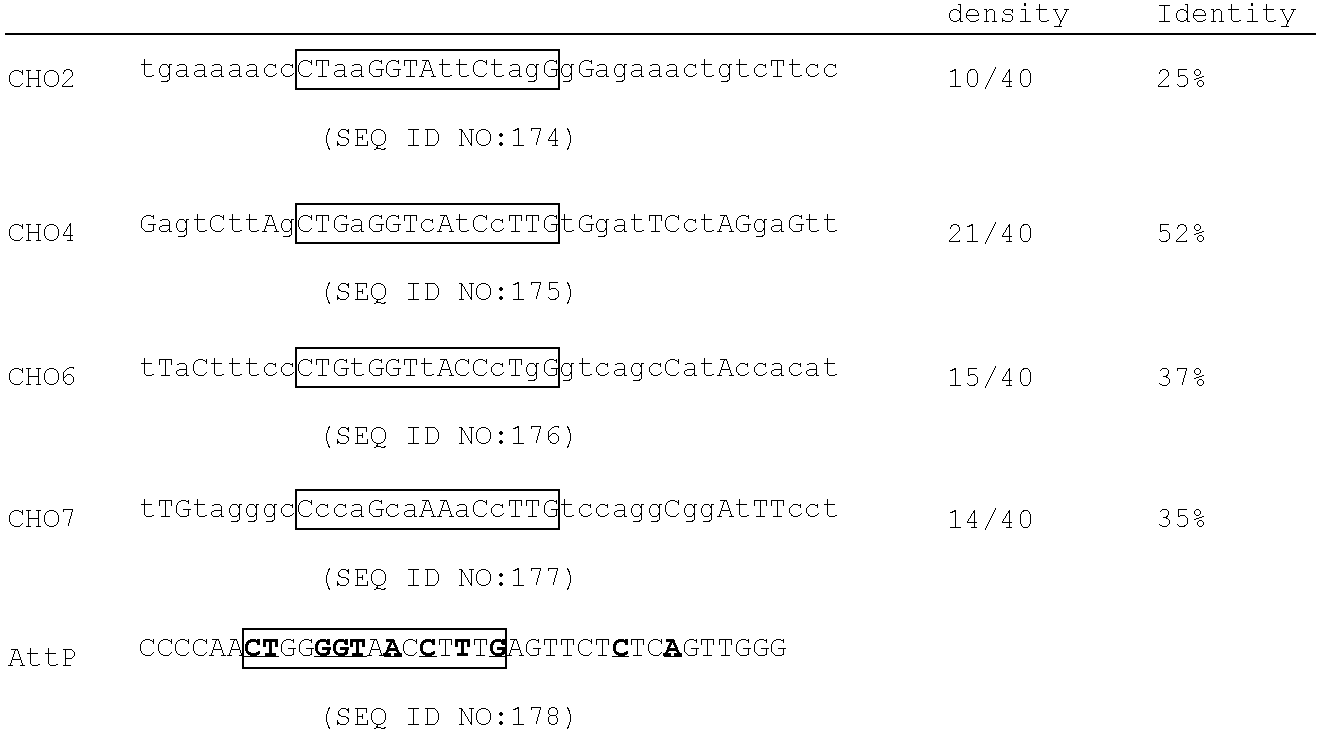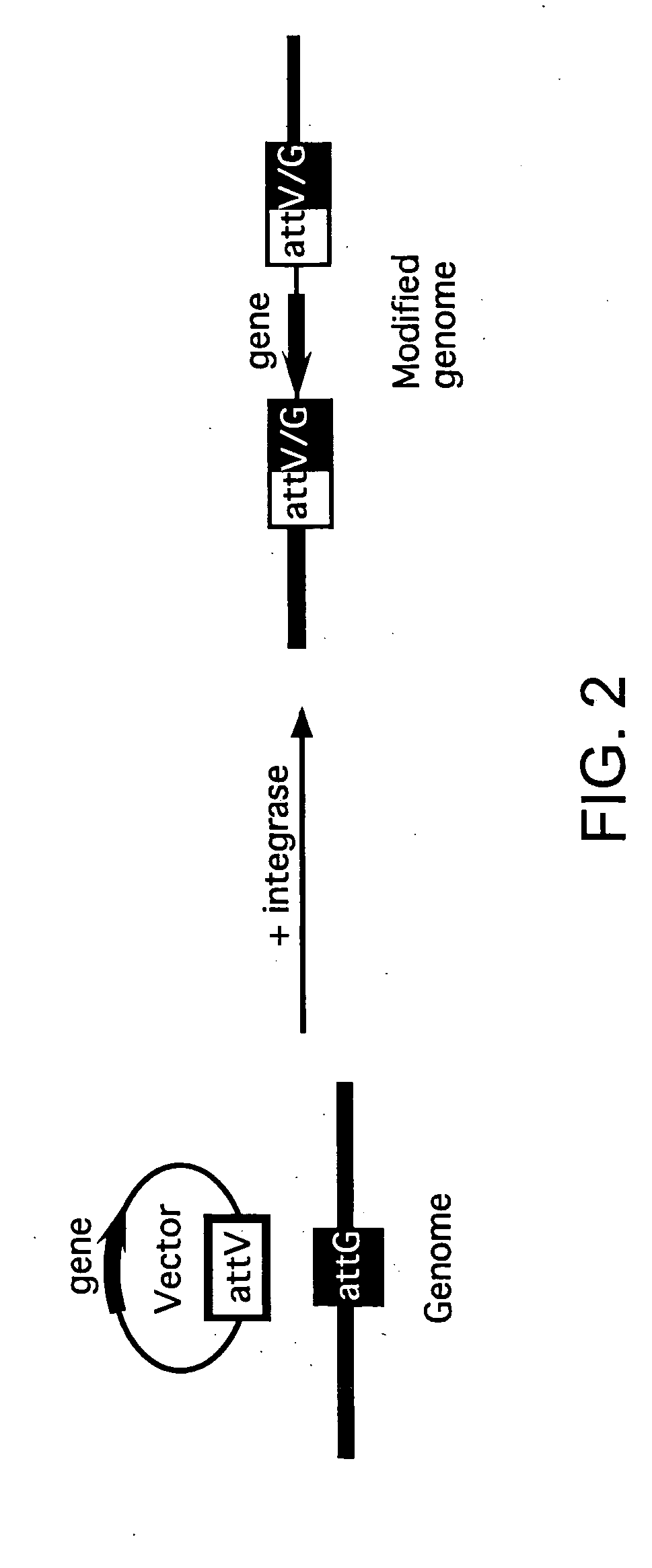Methods of unidirectional, site-specific integration into a genome, compositions and kits for practicing the same
a genome and site-specific technology, applied in the field of molecular biology, can solve the problems of inability to achieve site-specific recombination, limit the usefulness of the technique, and inability to integrate added gene sequences in an undesired manner, so as to facilitate site-specific recombination and reduce or avoid secondary recombination events
- Summary
- Abstract
- Description
- Claims
- Application Information
AI Technical Summary
Benefits of technology
Problems solved by technology
Method used
Image
Examples
example 1
Production of Mutant Integrases and Thermally-Induced Screening Assay for Identifying Mutant Integrases That Faciltiate Site-Specific Recombination with a Desired Recognition Site Pair
[0546] This assay uses two plasmids, called the resident plasmid (FIG. 3) and the cloning plasmid (FIG. 4). Construction of these plasmids was carried out as follows.
[0547] Resident plasmid. The temperature sensitive (TS) plasmid pTSK30 was used as the backbone for the final resident plasmid. pTSK30 (Phillips, G. J., Plasmid 41:78-81 (1999)) was cut with DrdI and SmaI to remove the lacZ alpha gene. The DrdI end was made blunt with T4 polymerase, gel isolated, and re-ligated to a compatible SmaI blunt end resulting in the plasmid pTSK1st. A special linker that provided unique recognition sites was placed into this vector. This linker sequence was CGCGtggtgc ttgcttagcg ctagcgcatg c (Linker 1; SEQ ID NO:106). The CGCG sequence shown in capitals (i.e., the first four nucleotides) is a M1uI overhang, wher...
example 2
Assaying Altered Integrases in Mammalian Cells
[0578] The screening assay for improved integrases was performed in E. coli. The altered integrases emerging from this screen can be tested in other species to determine if the desirable properties detected in bacteria are retained. The wild-type ΦC31 integrase and the 1C1 integrase mutants described in Example 1 were compared to each other in mammalian tissue culture cells for their ability to mediate the integration of a plasmid carrying the attB recognition site (FIG. 17B; SEQ ID NO:136) and the neomycin resistance gene into human chromosomes. Efficiencies of the integrases were determined by evaluating the number of neomycin resistant colonies formed after G418 selection.
[0579] The 293 human embryonic kidney cell line was used for these experiments (Graham, F. L., et al., J. Gen. Virol. 36, 59-72 (1977)). Cells were grown to 50-80% confluency in 60-mm-diameter dishes and transfected with 50 ng of the donor attB neo plasmid pNC-attB...
example 3
Methods to Identify Genome Attachment Sites and Knock Out the Human LDH-A Gene
[0583] Identification of genomic pseudo sites It is often useful to be able to choose a genomic site where integration is desired and to engineer an integrase to mediate integration at that site, even when the enzyme had no prior history of affinity for that location. In many applications, even though site-specific integration is required, integration anywhere within a region of 1 or more kb will produce the desired result.
[0584] Two general approaches can be applied to find pseudo att site sequences. The first is to introduce the target segments of DNA into the bacterial assay system for directed evolution (Sclimenti et al., 2001 Nucleic Acids Res. 2001 29:5044-51) and let the mutated integrase library choose a pseudo site. The other approach focuses on predicting with the computer where a potential pseudo site is located within the region of interest, allowing the screen to focus on a smaller region of...
PUM
 Login to View More
Login to View More Abstract
Description
Claims
Application Information
 Login to View More
Login to View More - R&D
- Intellectual Property
- Life Sciences
- Materials
- Tech Scout
- Unparalleled Data Quality
- Higher Quality Content
- 60% Fewer Hallucinations
Browse by: Latest US Patents, China's latest patents, Technical Efficacy Thesaurus, Application Domain, Technology Topic, Popular Technical Reports.
© 2025 PatSnap. All rights reserved.Legal|Privacy policy|Modern Slavery Act Transparency Statement|Sitemap|About US| Contact US: help@patsnap.com



